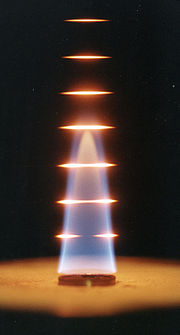
Thin filament pyrometry
Encyclopedia

Silicon carbide
Silicon carbide , also known as carborundum, is a compound of silicon and carbon with chemical formula SiC. It occurs in nature as the extremely rare mineral moissanite. Silicon carbide powder has been mass-produced since 1893 for use as an abrasive...
(SiC
SIC
Sic is a Latin word that means "thus" or, in writing, "it was thus in the source material".Sic may also refer to:* Sic, Cluj, a commune in Romania* SiC, Silicon carbide, a semiconducting material, also used to make metalworking tools from...
) fibers with a diameter of 15 micrometres. Temperatures of about 800 - 2500 K can be measured.
History
TFP was first used by V. Vilimpoc and L.P. Goss (1988). A recent paper using TFP is Maun et al. (2007).Technique
The typical TFP apparatus consists of a flameFlame
A flame is the visible , gaseous part of a fire. It is caused by a highly exothermic reaction taking place in a thin zone...
or other hot gas stream, a filament, and a camera.
Advantages
TFP has several advantages, including the ability to simultaneously measure temperatures along a line and minimal intrusiveness. Most other forms of pyrometry are not capable of providing gas-phase temperatures.Drawbacks
Calibration is required. Calibration typically is performed with a thermocoupleThermocouple
A thermocouple is a device consisting of two different conductors that produce a voltage proportional to a temperature difference between either end of the pair of conductors. Thermocouples are a widely used type of temperature sensor for measurement and control and can also be used to convert a...
. Both thermocouples and filaments require corrections in estimating gas temperatures from probe temperatures. Also, filaments are fragile and typically break after about an hour in a flame.

